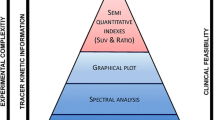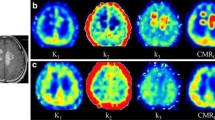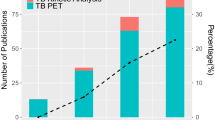Abstract
Purpose
Quantification of small-animal positron emission tomography (PET) images necessitates knowledge of the plasma input function (PIF). We propose and validate a simplified hybrid single-input–dual-output (HSIDO) algorithm to estimate the PIF.
Procedures
The HSIDO algorithm integrates the peak of the input function from two region-of-interest time–activity curves with a tail segment expressed by a sum of two exponentials. Partial volume parameters are optimized simultaneously. The algorithm is validated using both simulated and real small-animal PET images. In addition, the algorithm is compared to existing techniques in terms of area under curve (AUC) error, bias, and precision of compartmental model micro-parameters.
Results
In general, the HSIDO method generated PIF with significantly (P < 0.05) less AUC error, lower bias, and improved precision of kinetic estimates in comparison to the reference method.
Conclusions
HSIDO is an improved modeling-based PIF estimation method. This method can be applied for quantitative analysis of small-animal dynamic PET studies.


Similar content being viewed by others
References
Acton PD, Zhuang H, Alavi A (2004) Quantification in PET. Radiol Clin North Am 42(6):1055–1062, viii
Wienhard K (2002) Measurement of glucose consumption using [18F]fluorodeoxyglucose. Methods 27(3):218–225
Fang YH, Muzic RF Jr (2008) Spillover and partial-volume correction for image-derived input functions for small-animal 18F-FDG PET studies. J Nucl Med 49(4):606–614
Laforest R, Sharp TL, Engelbach JA et al (2005) Measurement of input functions in rodents: challenges and solutions. Nucl Med Biol 32(7):679–685
Gambhir SS, Schwaiger M, Huang SC et al (1989) Simple noninvasive quantification method for measuring myocardial glucose utilization in humans employing positron emission tomography and fluorine-18 deoxyglucose. J Nucl Med 30(3):359–366
Hoekstra CJ, Hoekstra OS, Lammertsma AA (1999) On the use of image-derived input functions in oncological fluorine-18 fluorodeoxyglucose positron emission tomography studies. Eur J Nucl Med 26(11):1489–1492
Ohtake T, Kosaka N, Watanabe T et al (1991) Noninvasive method to obtain input function for measuring tissue glucose utilization of thoracic and abdominal organs. J Nucl Med 32(7):1432–1438
Buvat I, Benali H, Frouin F, Bazin JP, Di Paola R (1993) Target apex-seeking in factor analysis of medical image sequences. Phys Med Biol 38(1):123–138
Di Paola R, Bazin JP, Aubry F et al (1982) Handling of dynamic sequences in nuclear medicine. IEEE Trans Nucl Sci NS-29:1310–1321
Sitek A, Gullberg GT, Huesman RH (2002) Correction for ambiguous solutions in factor analysis using a penalized least squares objective. IEEE Trans Med Imaging 21(3):216–225
Su Y, Welch MJ, Shoghi KI (2007) The application of maximum likelihood factor analysis (MLFA) with uniqueness constraints on dynamic cardiac microPET data. Phys Med Biol 52(8):2313–2334
Su Y, Welch MJ, Shoghi KI (2007) Single input multiple output (SIMO) optimization for input function estimation: a simulation study. Nuclear Science Symposium Conference Record, 2007. NSS '07. IEEE 6:4481–4484
Feng D, Wong KP, Wu CM, Siu WC (1997) A technique for extracting physiological parameters and the required input function simultaneously from PET image measurements: theory and simulation study. IEEE Trans Inf Technol Biomed 1(4):243–254
Wong KP, Feng D, Meikle SR, Fulham MJ (2001) Simultaneous estimation of physiological parameters and the input function——in vivo PET data. IEEE Trans Inf Technol Biomed 5(1):67–76
Feng D, Huang SC, Wang X (1993) Models for computer simulation studies of input functions for tracer kinetic modeling with positron emission tomography. Int J Biomed Comput 32(2):95–110
Ferl GZ, Zhang X, Wu HM, Huang SC (2007) Estimation of the 18F-FDG input function in mice by use of dynamic small-animal PET and minimal blood sample data. J Nucl Med
Meyer C, Weibrecht M, Peligrad DN (2006) Variation of kinetic model parameters due to input peak distortions and noise in simulated 82Rb PET perfusion studies. Nuclear Science Symposium Conference Record, 2006. IEEE 5:2703–2707
Wong K-P, Huang S-C, Fulham MJ (2006) Evaluation of an input function model that incorporates the injection schedule in FDG-PET studies. Nuclear Science Symposium Conference Record, 2006. IEEE 4:2086–2090
Shoghi KI, Welch MJ (2007) Hybrid image and blood sampling input function for quantification of small animal dynamic PET data. Nucl Med Biol 34(8):989–994
Phelps ME (2004) PET : molecular imaging and its biological applications. Springer, New York, 621 p
Segars WP, Tsui BM, Frey EC, Johnson GA, Berr SS (2004) Development of a 4-D digital mouse phantom for molecular imaging research. Mol Imaging Biol 6(3):149–159
El Fakhri G, Sitek A, Zimmerman RE, Ouyang J (2006) Generalized five-dimensional dynamic and spectral factor analysis. Med Phys 33(4):1016–1024
Su Y, Shoghi KI (2008) Wavelet denoising in voxel based parametric estimation of small animal PET images: a systematic evaluation of spatial constraints and noise reduction algorithms Phys Med Biol 53(21):5899–5915
University of California Los Angeles Department of Molecular and Medical Pharmacology UCLA Mouse Quantitation Project. (http://dragon.nuc.ucla.edu). Accessed March 2008
Huang SC, Wu HM, Truong D et al (2006) A public domain dynamic mouse FDG MicroPET image data set for evaluation and validation of input function derivation methods. Nuclear Science Symposium Conference Record, 2006. IEEE 5:2681–2683
Robb RA, Hanson DP, Karwoski RA et al (1989) Analyze: a comprehensive, operator-interactive software package for multidimensional medical image display and analysis. Comput Med Imaging Graph 13(6):433–454
Acknowledgments
This project was supported by internal funding to KIS and partly by funding from the NIH/NHLBI grant 5-PO1-HL-13851 and the Washington University Small Animal Imaging Resource (WUSAIR) R24-CA83060.
Author information
Authors and Affiliations
Corresponding author
Additional information
Significance: A novel input function model is proposed and validated for image-based estimation of input function. The proposed method will enable accurate quantitative analysis of small-animal PET images.
Rights and permissions
About this article
Cite this article
Su, Y., Shoghi, K.I. Single-Input–Dual-Output Modeling of Image-Based Input Function Estimation. Mol Imaging Biol 12, 286–294 (2010). https://doi.org/10.1007/s11307-009-0273-5
Received:
Revised:
Accepted:
Published:
Issue Date:
DOI: https://doi.org/10.1007/s11307-009-0273-5




